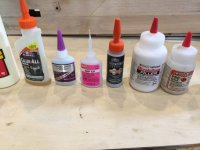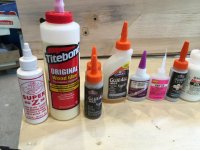The incidence has been set in both stabs and wings.
This step requires you use an assistant. This is by far, what I consider to be one of the most critical steps in the whole build, and this is the setting of the incidence.
Reason being is that all 4 surfaces need to have zero incidence relative to the power vector of the airplane. The motor goes on with no down thrust, it will have some right thrust, but invariably,this will require some adjustment after the trimming flights are done.
But, the recommendation for this airplane is zero for stabs and zero for the wings, although others have done some variations. I prefer to go by the recommendation from Tony Russo.
the 1st step is to assure that the top of the fuselage (which is parallel to the power vector of the airplane in X axis) (if you recall the airplane fuselage was built upside down on the plans) is level, and I did this by picking up the tail of the airplane and shimming it til it was ZERO with my incidence meter. Not only this, but i checked measurements in multiple locations to assure it was zero everywhere, and it was.
2nd step, the stabs need to have two components that help maintain the incidence. By far the most important one is the anti-rotation pin, towards the front of the stab. Mine will be made of titanium, about 1.5" long, and the inner part that will be glued in has been scored, to help with glue interdigitation. The outer part will have the tip rounded off, looks like the tip of a 22 round. The other component, is the bracket, that screws into the bottom of the root of the stab. Again, this only is an issue in that, once the stab is set, you do not want this to pull/push/hang up the stab, and therefore, you must remove the balsa under it, and glue in a plywood layer, so that it does not get crushed (if ti were balsa) which can then change the pressure of the bracket on the stab.
3rd step, place the stab on one side only, place the incidence meter on it, then have your assistant turn it until it reads zero, then from the other side, use some form of a triple guide system, to drill a small hole from the opposite side into the hard point on the stab. Once this "pilot hole" is drilled in, also, BTW, make sure not to plunge too deep, as you will end up coming out the LE of the stab. I marked my drill bit with a piece of tape. Once drilled in with the smaller drill, then you can remove the triple guide, and use the appropriate sized drill bit, which turns out to be 1/4", and drill into the hard point. Throughout, assuring that the incidence meter reads zero, and again, you checking to make sure that the fuselage has not moved either.
Once the hole is drilled, I trial fit the titanium pin, then install it to the fuselage, and recheck the incidence, if it still reads Zero, then I Glue it in with 30 minute epoxy.
AFTER THIS, THEN keeping the stab on the fuselage, i then get a smaller drill bit, and drill thru the bracket into the fuselage, and now i place a 6-43 blind nut on the inside of the fuselage, to then allow me to fix the stab to the fuselage with one screw. I will use another screw that goes into the stab tube.
i have modified the drill bit, in that, i have sanded down the tip, so it acts now like a step drill.
the stab incidence is done.
setting the wing incidence, drill in one side, to the hard point in the wing, make sure it reads zero, then i insert a pin into the hole drilled, then i drill into the other hard point, again, measuring and checking that the incidence has not changed, then i removed the wing, and glued in the thread studs with 30 minute epoxy.
Glued on the 1/16th balsa by 3/4" wide strip to the top of the fuselage, where the turtle deck foam and balsa will have increased surface area to glue onto.
From looking at the plans and at the actual turtle deck, it became apparent to me, that the turtle deck was too long, so i cut some off the rear aspect of it, to make it fit.
Applying glue to it now!
Turtle deck going in!!
After this, the canopy hatch area!



























